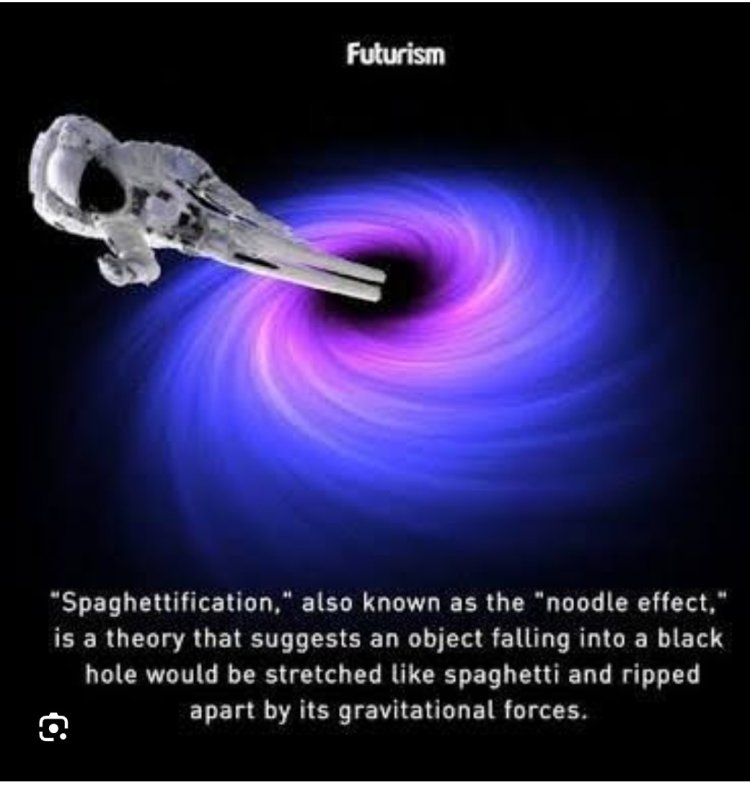Spaghetification
Spaghetification is a perfect example of how black holes take normal physics laws and push them to extremes.

Spaghettification.
What Really Happens If You Fall Into a Black Hole.
Black holes are among the most mysterious and extreme objects in the universe. Their gravity is so strong that not even light can escape once it crosses the event horizon—the point of no return.
But what happens if a person—or anything—ventures too close?
One of the strangest predicted effects is spaghettification, where you’d be stretched into a thin, noodle-like shape. Let’s explore the science behind this bizarre cosmic fate.
The Basics: Gravity Gone Wild
To understand spaghettification, you need to know how gravity works.
Gravity pulls more strongly on objects the closer they are to its source. On Earth, the difference in gravitational pull between your head and feet is tiny—so small you don’t feel it.
Near a black hole, things change dramatically. The gravitational gradient—the difference in gravity between two points—is so steep that the pull on your feet can be thousands or millions of times stronger than the pull on your head (if you fall feet-first).
This massive difference in pull is called a tidal force. The term comes from how the Moon’s gravity raises tides on Earth, but near a black hole, these tidal forces are deadly.
Falling Toward the Singularity
Let’s imagine you’re drifting toward a stellar-mass black hole (about 10 times the mass of the Sun). As you approach:
1. Far away – You’d feel normal, just accelerating toward it.
2. Closer in – You’d feel an intense pull at your feet, stretching your body vertically.
3. Even closer – The stretching force becomes overwhelming, and your body elongates like a piece of spaghetti.
Your body’s atoms themselves would start to experience vastly different forces, pulling apart molecules, atoms, and even subatomic particles as you near the singularity—the infinitely dense center of the black hole.
Why It’s Called Spaghettification
Astrophysicists coined the term because the stretching resembles pulling dough into thin spaghetti strands. In reality, it’s more violent than any pasta-making process—by the end, you’re not just stretched; you’re shredded on an atomic level.
Small vs. Supermassive Black Holes
Interestingly, your experience depends on the size of the black hole:
Small Black Hole (stellar-mass)
The tidal forces near the event horizon are enormous. You’d be stretched and torn apart before you even crossed it.
Supermassive Black Hole (millions to billions of solar masses)
Near the event horizon, the gradient is gentler because it’s farther from the singularity. You could actually cross the horizon without immediate spaghettification—only to be torn apart later, much deeper inside.
In both cases, your journey ends at the singularity, but the timing of the “noodle effect” changes.
From Your Perspective vs. An Observer’s Perspective
Physics gets even stranger here:
1.From your perspective – Time seems normal as you fall. You’d see the black hole’s surroundings warp, and the light from outside space would distort into strange shapes.
2.From a distant observer’s perspective – You’d appear to slow down, freeze, and fade as you approach the event horizon, never quite crossing it. This is due to gravitational time dilation, a mind-bending prediction of Einstein’s relativity.
The Physics Formula for Spaghettification
The tidal acceleration can be approximated by:
a \approx \frac{2GMd}{r^3}
Where:
= gravitational constant
= mass of the black hole
= your height (distance between head and feet)
= distance to the center of the black hole
The smaller is, the stronger the stretching force. For a small black hole, gets small fast, meaning forces become lethal quickly.
Can Anything Survive It?
In reality, no known material could survive these forces—not steel, not diamond, not even neutron-star matter. Once inside a black hole, there’s no coming back, because even information about what happens to you is trapped beyond the event horizon.
The Cosmic Takeaway
Spaghettification is a perfect example of how black holes take normal physical laws and push them to extremes.
It’s a mix of two mind-bending effects:
Tidal forces from extreme gravity
Relativity’s distortion of time and space
If you ever find yourself falling into a black hole, remember this comforting fact:
You won’t have time to worry—you’ll be cosmic spaghetti long before you can regret your life choices.
Objects near a black hole so the spaghettification process is easier to visualize. That visual really drives the point home.












